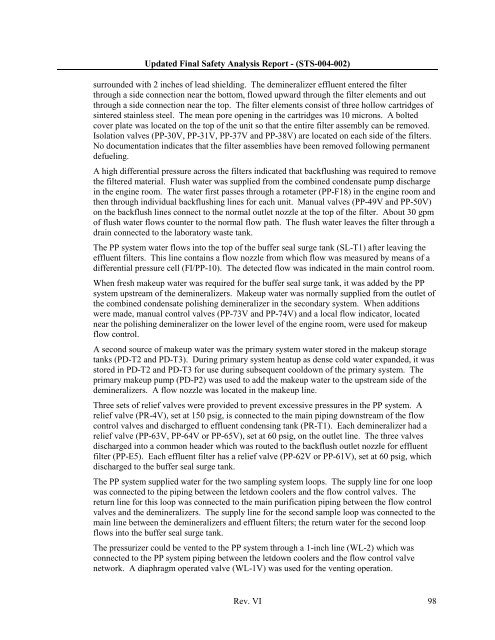10 CFR 50.71(e) - Maritime Administration - U.S. Department of ...
10 CFR 50.71(e) - Maritime Administration - U.S. Department of ...
10 CFR 50.71(e) - Maritime Administration - U.S. Department of ...
Create successful ePaper yourself
Turn your PDF publications into a flip-book with our unique Google optimized e-Paper software.
Updated Final Safety Analysis Report - (STS-004-002)surrounded with 2 inches <strong>of</strong> lead shielding. The demineralizer effluent entered the filterthrough a side connection near the bottom, flowed upward through the filter elements and outthrough a side connection near the top. The filter elements consist <strong>of</strong> three hollow cartridges <strong>of</strong>sintered stainless steel. The mean pore opening in the cartridges was <strong>10</strong> microns. A boltedcover plate was located on the top <strong>of</strong> the unit so that the entire filter assembly can be removed.Isolation valves (PP-30V, PP-31V, PP-37V and PP-38V) are located on each side <strong>of</strong> the filters.No documentation indicates that the filter assemblies have been removed following permanentdefueling.A high differential pressure across the filters indicated that backflushing was required to removethe filtered material. Flush water was supplied from the combined condensate pump dischargein the engine room. The water first passes through a rotameter (PP-F18) in the engine room andthen through individual backflushing lines for each unit. Manual valves (PP-49V and PP-50V)on the backflush lines connect to the normal outlet nozzle at the top <strong>of</strong> the filter. About 30 gpm<strong>of</strong> flush water flows counter to the normal flow path. The flush water leaves the filter through adrain connected to the laboratory waste tank.The PP system water flows into the top <strong>of</strong> the buffer seal surge tank (SL-T1) after leaving theeffluent filters. This line contains a flow nozzle from which flow was measured by means <strong>of</strong> adifferential pressure cell (FI/PP-<strong>10</strong>). The detected flow was indicated in the main control room.When fresh makeup water was required for the buffer seal surge tank, it was added by the PPsystem upstream <strong>of</strong> the demineralizers. Makeup water was normally supplied from the outlet <strong>of</strong>the combined condensate polishing demineralizer in the secondary system. When additionswere made, manual control valves (PP-73V and PP-74V) and a local flow indicator, locatednear the polishing demineralizer on the lower level <strong>of</strong> the engine room, were used for makeupflow control.A second source <strong>of</strong> makeup water was the primary system water stored in the makeup storagetanks (PD-T2 and PD-T3). During primary system heatup as dense cold water expanded, it wasstored in PD-T2 and PD-T3 for use during subsequent cooldown <strong>of</strong> the primary system. Theprimary makeup pump (PD-P2) was used to add the makeup water to the upstream side <strong>of</strong> thedemineralizers. A flow nozzle was located in the makeup line.Three sets <strong>of</strong> relief valves were provided to prevent excessive pressures in the PP system. Arelief valve (PR-4V), set at 150 psig, is connected to the main piping downstream <strong>of</strong> the flowcontrol valves and discharged to effluent condensing tank (PR-T1). Each demineralizer had arelief valve (PP-63V, PP-64V or PP-65V), set at 60 psig, on the outlet line. The three valvesdischarged into a common header which was routed to the backflush outlet nozzle for effluentfilter (PP-E5). Each effluent filter has a relief valve (PP-62V or PP-61V), set at 60 psig, whichdischarged to the buffer seal surge tank.The PP system supplied water for the two sampling system loops. The supply line for one loopwas connected to the piping between the letdown coolers and the flow control valves. Thereturn line for this loop was connected to the main purification piping between the flow controlvalves and the demineralizers. The supply line for the second sample loop was connected to themain line between the demineralizers and effluent filters; the return water for the second loopflows into the buffer seal surge tank.The pressurizer could be vented to the PP system through a 1-inch line (WL-2) which wasconnected to the PP system piping between the letdown coolers and the flow control valvenetwork. A diaphragm operated valve (WL-1V) was used for the venting operation.Rev. VI 98
















